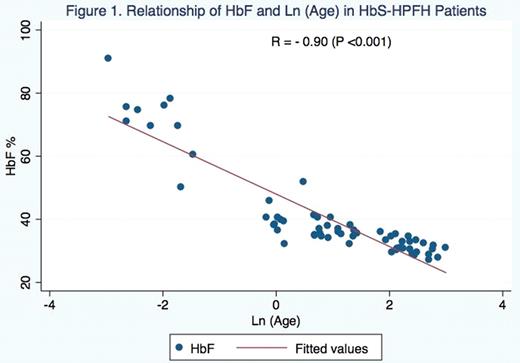Abstract
Abstract 1626
In gene deletion hereditary persistence of fetal hemoglobin (HPFH) affecting people of African descent, more than 80 kb of DNA is deleted including the δ- and β-globin genes and downstream sequences. Compound heterozygotes for sickle hemoglobin (HbS) and HPFH have high fetal hemoglobin (HbF) levels and have few if any sickle cell disease-related complications. Among patients with sickle cell disease who were referred for hemoglobin diagnostic testing, 28 compound heterozygotes for HbS and HPFH (6 HPFH type 1 and 22 HPFH type 2) were identified. The diagnosis of HbS and HPFH 1 and 2 were confirmed by DNA-based specific gap-PCR tests. We characterized factors associated with HbF and its changes over time to better understand the modulation of HbF in this population. Laboratory information were obtained through chart review and/or extracted from information provided at the time of hemoglobin diagnostic testing. Data regarding age at which HbF was measured allowed us to study the change in HbF over time. For comparison, we analyzed data collected through the Cooperative Study of Sickle Cell Disease (CSSCD) containing over 3000 HbF measurements at different ages in HbS homozygotes (HbSS) or HbS-β0 thalassemia patients. Statistical analyses were performed using Stata/SE11.1 software. In 28 HbS-HPFH cases, 62 HbF values at different ages ranging from the newborn period to age 20 years were available for analysis. In these patients, HbF was 50% to 90% during infancy and declined steeply within the first few years of life, stabilizing between ages 3 to 5 years. Mean HbF at age 5 or older was 31 ± 2%. Mean hemoglobin concentration was 13 ± 1g/dL and mean MCV was 75 ± 6 fL. Age was log-transformed for all analyses. In univariate and multivariate regression analyses, HbF was significantly associated with age, hemoglobin concentration, and MCV (P<0.001). There was no relationship with gender or genotype of HPFH. There was a strong inverse correlation between HbF and age (r=-0.9, P<0.001). Likewise, in patients with HbSS or HbS-β0 thalassemia from the CSSCD database, HbF was significantly associated with age, hemoglobin concentration, and MCV. In the CSSCD population alone, HbF was also associated with female gender. Patients with compound heterozygosity for HbS and HPFH have a logarithmic age related decline in HbF with marked decline during the first few years of life and plateauing at a HbF of approximately 30% in adulthood. Although these patients maintained a higher HbF after early childhood, their HbF is subjected to a similar age-related decline as seen in patients with other genotypes of sickle cell disease. Future studies aimed at understanding age related regulation and distribution of HbF in these and other patients may offer insight into mechanisms that can halt decline of HbF and ameliorate sickle cell disease.
No relevant conflicts of interest to declare.
Author notes
Asterisk with author names denotes non-ASH members.


This feature is available to Subscribers Only
Sign In or Create an Account Close Modal